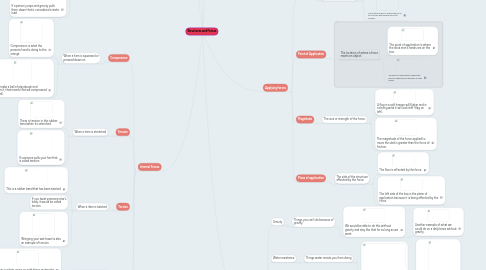
1. Loads
1.1. Live load
1.1.1. The weight of living things
1.1.1.1. Example of a live load
1.1.1.2. This is an example of a live load on a chair.
1.2. Dynamic Load
1.2.1. The force that moves or changes while acting on a structure
1.2.1.1. Example of a dynamic load(wind)
1.2.1.2. Rain is also an example of a dynamic load.
1.3. Dead Load
1.3.1. A constant load
1.3.1.1. Example of a dead load
1.3.1.2. A dead load can also be a shopping basket with groceries in it.
1.4. Static Load
1.4.1. The effect of gravity on a object or structure
1.4.1.1. Example of a static load(the effect gravity has on this structure is push it too the ground, so the higher this tower the more likely to fall)
1.4.1.2. If a person jumps and gravity pulls them down that is considered a static load
2. Internal Forces
2.1. Compression
2.1.1. When a item is squeezed or pressed down on
2.1.1.1. Compression is what the persons hand is doing to the orange
2.1.1.2. If we make a ball of playdough and flatten it, that means that we compressed the ball.
2.2. Tension
2.2.1. When a item is stretched
2.2.1.1. There is tension in this rubber band when its stretched
2.2.1.2. If someone pulls your hair that is called tension
2.3. Torsion
2.3.1. When a item is twisted
2.3.1.1. This is a rubber band that has been twisted
2.3.1.2. If you twist someone else's body it would be called torsion.
2.3.1.3. Wringing your wet towel is also an example of torsion.
2.4. Shear
2.4.1. When two objects rub and go in opposite direction.
2.4.1.1. Shear is whats going on with these rectangles
2.4.1.2. cutting something with scissors is a good example of shear.
2.5. Internal forces are forces that act on the inside of a structure.
3. Stability
3.1. Structural Failiure
3.1.1. A structure that breaks because of internal and external forces
3.1.1.1. An example of structural failiure is when a house collapses because of a natural gas explosion
3.1.1.2. Structural failiure can also be when you are pulling too hard on a object such as an elastice band and then it breaks because of tension
4. Air Resistance
5. Types of Structures
5.1. Shell
5.1.1. A hollow structure thats still strong
5.1.1.1. An egg is an example of a shell structure
5.1.1.2. A second example of a shell structure is a sailboat
5.2. Solid
5.2.1. A structure solid all the way through
5.2.1.1. Ice is a example of a solid structure
5.2.1.2. A sturdy table is also an example of a solid structure
5.3. Frame
5.3.1. Different parts fastened together making a structure
5.3.1.1. A house that isn't finished being built is a frame structure
5.3.1.2. The skeleton of a human body is also a frame structure.
5.4. Combination
5.4.1. A structure containing a combination of shell,frame,shell and solid structures
5.4.1.1. A car is an example of a combination structure
5.4.1.2. Another example of a combination structure is a bridge.
6. Applying forces
6.1. Direction
6.1.1. The way the force makes an object move.
6.1.1.1. The cube is moving in a direction.
6.1.1.2. The football player is kicking the ball in front of him and the ball will move forward.
6.2. Point of Application
6.2.1. The location of where a force meets an object.
6.2.1.1. The point of application is where the stick man's hands are on the box.
6.2.1.2. The point of application is where the persons fingers touch the keys to start typing.
6.3. Magnitude
6.3.1. The size or strength of the force.
6.3.1.1. A flag in a soft breeze will flutter and in a strong wind it will look stiff (flag on left).
6.3.1.2. The magnitude of the force applied to move the sled is greater than the force of friction.
6.4. Plane of application
6.4.1. The side of the structure affected by the force.
6.4.1.1. The floor is affected by the force.
6.4.1.2. The left side of the box is the plane of application because it is being affected by the force.
7. External Forces
7.1. Gravity
7.1.1. Things you can't do because of gravity.
7.1.1.1. We would be able to do this without gravity and stay like that for as long as we want.
7.1.1.1.1. Another example of what we could do on a daily basis without gravity.
7.2. Water resistance
7.2.1. Things water resists you from doing
7.2.1.1. Example of water resistance
7.2.1.1.1. Example of water resistance
7.3. Fricton
7.3.1. To surfaces rubbing against each other forcing one to stop
7.3.1.1. Example of friction
7.3.1.2. Riding a bike on a bumpy road is friction because the road is forcing you to stop.
7.4. Air resistance
7.4.1. The force that acts in the opposite direction your traveling
7.4.1.1. When driving a car this is air resistance acting in the oppsite direction your driving
7.4.1.1.1. This is why parachutes work because since your falling down,towards earth air resistance flows up which allows the parachute to get filled with hair and lower you safely to the ground

